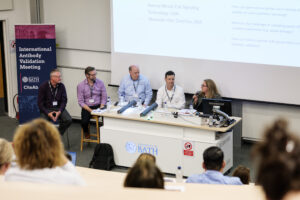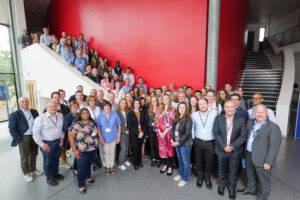University of Bath, UK, September 13-15, 2023
Organizer: Dr. Andrew Chalmers
Meeting report written by: Dr. Simon Goodman
Photos reproduced by kind permission Andrew Chalmers, CiteAb. Copyright Tim Gander, University of Bath.
Some 7 million research tool antibodies (i.e., non-diagnostic or therapeutic reagents) are identified in the CiteAb database [1]. But a unified process for validating antibody functionality remains elusive, with severe negative effects for the research community [2].
The International Antibody Validation Meeting is an international forum covering this topic. This, the 4th iteration of the meeting (AB23), was held in Bath, following a multi-year-Covid-19-induced hiatus. AB23 gathered concerned parties from academia and industry and, once again, it was a great success.
Dr. Andrew Chalmers, meeting organiser and CEO of CiteAb, provided orientating introduction and endpieces, and his team smoothly orchestrated the well-structured program. AB23 was a day longer than previous meeting iterations, allowing more discussion, and an expert discussion forum.
A number of themes have emerged since the last meeting [3], notably amongst them technologies for high-multiplexing in immunohistochemistry (IHC). This is enabling spatial biology, but does highlight the importance of strong antibody validation.
Peter MacPherson (McGill; YCharOs) showed the impact of poor antibodies. YCharOs use open-science to publish validations of antibodies (Abs) against targets nominated by their funders. They focus on commercial sources for discovering high-quality (i.e., specific; selective) Abs which can then be used to generate recombinant resources. Peter, in a characteristically exciting talk, presented the example of antibodies targeting C9ORF72 proteins, which are relevant in amyotrophic lateral sclerosis. The majority of commercially available “anti-C9ORF72” Abs did not recognize the target, and the principal Ab that does has rarely been used in the literature. This situation mirrors the sad story of estrogen receptor-beta related in the Antibody Validation Webinar series [2]. YCharOS have screened over 640 Abs against 65 targets [4]. Less than 50% perform according to manufacturers’ descriptions (in Western blot (WB) and in immunofluorescence (IF)). On a very positive note, many reagents YCharOS found to be inadequate were subsequently removed from the market by their suppliers.
Speakers from major research-tool-antibody suppliers, Anthony Wood (CST; Cell Signalling Technology), Will Howat (Abcam), David Piper (ThermoFisher), Kit Nazor (ProteinTech) and Mathias Uhlén (KTH; Atlas/Human Protein Atlas (HPA)) described their commitments to validation, but with some differences in focus. There was general agreement that of the current methods for Ab validation [5, 6], genetic knock-out (KO) and knock-downs give the strongest supporting evidence. But for IHC of human samples, this is clearly inaccessible. Cell-based KO and knock-down are now routinely used by Abcam, CST and ThermoFisher in development pipelines. Mathias Uhlén (KTH) reminded us that, 15 years ago, only some 50% of Abs from commercial suppliers were found to function as intended [7]. It is depressing that, despite the increase in awareness since then, the ratio of “good” to “bad” reagents appears not to have shifted, as related by Peter McPherson. For HPA Abs, when genetic approaches (e.g., CRISPR-KO) are inaccessible, they favour using Abs against different epitopes on the same antigen for validations. HPA now generates “synthetic epitope maps” by aligning genome-wide peptide array-screens of their Abs onto models produced by AlphaFold2 [8]. But, as one questioner noted, for IHC, 3 Abs against the “same” antigen may ever yet produce 3 different distribution patterns, due to differential exposure of epitopes. Some 55,000 Abs produced by HPA against human proteins contribute to the >10E6 IHC images displayed in the Antibodypedia [9], with 37% of HPA Abs validated by WB and 24% by IHC. Despite widespread enthusiasm for recombinant tool Abs, HPA find they tend to perform poorly in IHC and WB, although rabbit recombinants (RabMabs) perform better than murine recombinants (rMabs). This may be due to the antigens used, as noted subsequently.

Left to right:
Antony Wood
Cell Signaling Technology, USA
Kristopher Nazor
Proteintech, USA
Dr Alexander Ball, GeneTex USA
Matt Baker, Thermo Fisher, USA
Alejandra Solache, Abcam, UK
Photo © Tim Gander. All rights reserved.
Will Howat emphasized that good Abs are encouraged by using high-quality immunogens. Abcam continues to move to a predominantly recombinant environment. Tens of thousands of ascites reagents have now been exchanged with KO-validated RabMab, while thousands of Abs shown as incorrectly validated have been removed from the Abcam catalogue. It would be valuable if all suppliers noted when Abs have been invalidated. This might enable database resources (e.g., Medline; CiteAb; Antibodypedia) to tag such bad reagents and to alert users when they have been cited.
Anthony Wood focused on how CST “de-risks data” when validating for multiplex – and the need for an application-specific approach. He used the example of YAP vs. TAZ- antibodies. Although encoded by different genes, antibodies discriminating between YAP and TAZ are hard to obtain. CST used RNA profiles from the HPA for selecting tissue panels. This allowed successful screening for YAP vs. TAZ Abs. In multiplex, the CST SignalStar system allows simultaneous 3- 8-plex IF staining in manual procedures, and many more on the high-multiplex Cell DIVE platform. CST use site-specific oligo-conjugation for Mab tagging, which gives high reproducibility compared to non-site-specific coupling protocols. Both Anthony and David Piper emphasized the necessity for application-specific validation: you get the antibody you screen for in the experimental context of the screen. CST publish standardized validation protocols; users were urged to use these before believing a reagent “does not work”.
All producers encouraged users to contact them if supplied antibodies do not “work to specification”: they do greatly welcome and need this feedback!
The contrast between the primary suppliers and the diagnostic and pharmaceutical companies was notable in the necessarily finer granularity of the validations used. Lena D’Hooghe (UCB Biopharma), Anthony Couvillon (Mercy BioAnalytics), Kevin Harvey (Aviva Systems Biology) and Elena Ivanova (Regeneron) discussed general approaches, while Nicola Lawson (AstraZeneca) detailed efforts on PD-L1 antibodies. Lena D’Hooghe described screening on phage- yeast and animal- display platforms, and how Ab format, variable and Fc-regions were optimized. Elena Ivanova validates for IHC using RNAseq databases to identify high- and low-expressing tissues as target-expression standards. Multiple Ab expression in IHC is matched to RNAseq data. Only 3 of 8 commercial antibodies against F4/80 showed tissue-specific, low background signal on a variety of tissues. Lead Abs were optimized by titration. In a contrasting approach, Kevin Harvey described searches for robust polyclonal (pAb) pairs against cancer biomarkers. Aviva use AlphaFold models to identify likely antigenic C-terminal, N-terminal and mid-protein sequences, from which they select 14-mer oligopeptide immunogens [8]. Automated production allows Ab pairs to 60 antigens per month to be generated. Aviva use a high-throughput surface plasmon resonance system to rapidly identify multiple matched pairs of high-affinity pAbs (with “monoclonal-similar kinetics”). Anthony Couvillon focuses on liquid biopsy (extracellular-vesicle) targets for early cancer detection. Commercially available Abs are screened to identify capture-detection pairs.
An interesting contrast was provided by speakers discussing multiplex-staining, which is now advancing fast to enable a “spatial biology” where potentially quantitative molecular data-streams are matched to 2D- and likely future 3D-positional information. This has been possible for gene-expression for years using fluorescent in-situ hybridization, but for Ab-based protein detection the challenges are significantly greater.
With well validated Abs, spatial biology is likely to be transformative in many fields. Naturally, issues of validation in monoplex, especially in IHC, take on a different intensity when tens or hundreds of targets are being investigated in parallel. High-plexes currently rely on cyclic bleaching of fluors, Ab- or fluor-removal protocols, sometimes used in combination with non-classical Ab labels (oligonucleotides or, not discussed in this meeting, metals).
For high-multiplex IF, the challenge is to gather and register high-fealty signals, whilst preserving tissue architecture and proteome-wide antigenicity through repeated cycles of staining and “destaining”. Issues of Ab validation are therefore combined with the problems of “destaining” involving bleaching or removing fluorochromes or antibodies under very mild conditions, since conventional optics give strong channel discrimination of only some 4 colours. CSTs SignalStar approach of cyclic fluorochrome bleaching contrasted with the approaches of Milteny presented by Andreas Bosio. He described the proprietary IHC MACsima system which repeats 4 colour stainings, and uses a combination of photobleaching, photo- fluor-release and photo-Ab release in each staining and data-aquisition cycle. More than 200 targets can currently be routinely multiplex stained. There is as yet no evidence of steric hindrance at such levels of multiplex. Clearly, the quality and validation of the Abs used is critical, and Milteny use reagents made and characterized in-house. As with CST, KO cell lines, RNAi knock down, and over-expression are the routine validation tools. High-plex tissue staining profiles are validated by comparison with the monoplex signal, with HPA, by alignment to appropriate tissue architecture, with published data, and to staining observed in HuBMAP [10] and the OMAP Ab panels. In an interesting description of the issues of background in multiplex (increasing linearly with Ab concentration) and signal (following sigmoid kinetics), kinetic binding analysis showed that incubations resulting in 75% epitope coverage for each Ab gave optimal signal-to-noise ratios, and also allowed a good estimate of epitope number from the fluorescent signal.
Kit Nazor described a production pipeline for DNA-oligo-tagged Abs. Protein Tech use a fully automated flow-chain moving from Mab clones-to-DNA and generating up to 200 rMabs a week. 850 well-validated tagged Abs are currently available. In use, tissue microarrays on the Vizium platform show as yet “no upper limit” for the -plex of Ab staining that is possible even when using hundreds of Abs simultaneously, without stripping off bound Abs.
Andrea Radtke (NIAID – NIH) described the HuBMAP consortium [11], an open-source effort which among many other initiatives is establishing robust multiplex (>50-plex) Ab staining-panels for human tissues. Andrea’s talk was accompanied by exquisite IF images as, of course, were those of many other speakers! Interestingly, HuBMAP often use fixed-frozen tissue, rather than more widely available formalin-fixed-paraffin embedded resources.
Likely due to time constraints, speakers did not discuss issues of detecting post-translational modifications in multiplex.
Moving from the general to specific, Nicola Lawson described the validation of PD-L1 Abs. The PD-L1 / PD1 system is a therapeutic target in oncology, and patient stratification requires quantification in biopsies by IHC. However, different clinical IHC assays using different diagnostic Abs give variable data. This complicates stratification. Elegant analysis clustered the binding sites of the Abs to a site at the C-terminus of PD-L1 or to two sites on the extracellular domain. Nicola noted that even the “well-validated” Abs used as diagnostics may have unexpected binding properties that complicate their usage.
Dean Clift (LMB Cambridge) reminded us of Trim-Away [12]. TRIM21 , a cytoplasmic Ab receptor and E3 ubiquitin ligase, programs cytoplasmic antigens bound by Abs for degradation.Trim-Away allows direct protein-KO for validating Abs against cytoplasmic targets, independent of genetic KO.
The extended meeting also featured talks addressing different perspectives on “standard Ab validation”. Katarzyna Kmiecik (Alcemab Therapeutics) described mining therapeutics from rare human populations. Alcemab hypothesises that Ab response(s) help protect long-term survivors of high-mortality diseases (e.g., pancreatic carcinoma), people without cognitive decline or serious illness in old age, and people who, despite high-risk beta-amyloid and APOE4 alleles, show little cognitive decline. Alcemab sequence patient B-cell repertoires and use machine learning to find convergent clones. These are deconvoluted to identify potential therapeutic targets and yield a unique “data-cube” of Ab-antigen combinations from unique patient populations.
Asel Sartbaeva (EnsiliTech) described technology to thermally stabilize labile biologicals (e.g., vaccines; therapeutic Mabs). Only 7% of US Food and Drug Administration-approved drugs are stable at room temperature, and some BN $35 / year of vaccines and therapeutics are lost world-wide to cold-chain failure. EnsiliTech’s results for promoting long-term stability of vaccines and for trastuzumab are impressive. The process is simple, readily reversible, and uses materials standard in galenics. It could be transformative if it were applied where cold chains are friable.
Ibolya Kepiro (National Physics Laboratory (NPL)) described biological standards and standardized synthetic materials to allow rigorous identification in electron microscopy of viruses, and for other biological applications. Identification is complicated by the heterogeneity of biological samples, Ibolya gave the example of amyloidosis where inadequate protocols have existed for diagnosis, due to the lack of rigorous biological standards. NPL offers collaborative services to industry or academia aimed at solving such problems.
Pierre Cosson (University of Geneva) described the ABCD database, which gathers Ab and antigen sequence information. The facility makes Mabs from the sequences on demand. The database also allows the encoding of industrial-sector Abs, to allow comparison with other recombinant reagents in the database, but without public disclosure of sequence.
An open-discussion forum gave an opportunity to quiz providers. Thoughts about how to address the persistent lack of knowledge of Ab validation issues, especially amongst young scientists were raised. Amongst the posters, Harvinder Virk (University of Leicester) described OGA (“Only Good Antibodies”), an open-source community wide effort for Ab validation; Jan Voskuil (Aeonian) described a novel Ab quality-ranking algorithm; and Klaus Wanisch (Addgene) described a unique highly validated neuroscience Ab set (Jim Trimmer; University Davis, CA).
As the conference drew to a close, Dr. Chalmers expressed his gratitude to attendees, speakers, sponsors, and of course to the excellent session chairs for making AB23 a success. He emphasized the importance of continued collaboration and innovation in Ab validation to ensure increased robustness of research, while participants left armed with fresh insights. As the research community continues to strive for excellence in experimental reproducibility and data integrity, we can look forward to the next meeting in the series which, like AB23, will play a central role in helping to shape antibody validation research.

Delegate networking, refreshments and poster session discussion.
Photo © Tim Gander. All rights reserved.
- Helsby,M.A., et al. CiteAb: a searchable antibody database that ranks antibodies by the number of times they have been cited. BMC Cell Biol, 2014. 15: p. 6.
- Voskuil J.L.A., et al. The Antibody Society’s antibody validation webinar series. MAbs, 2020. 12(1): p. 1794421.
- Goodman S.L. The 3rd Antibody Validation meeting: Bath, UK, 20-21 September 2018. F1000Res, 2018. 7: p. 1989.
- Biddle M.S., Virk H.S. YCharOS open antibody characterisation data: Lessons learned and progress made. F1000Res, 2023. 12: p. 1344.
- Roncador G., et al. The European antibody network’s practical guide to finding and validating suitable antibodies for research. MAbs, 2016. 8(1): p. 27-36.
- Uhlen,M., et al. A proposal for validation of antibodies. Nat Methods, 2016. 13(10): p. 823-7.
- Berglund, L., et al. A genecentric Human Protein Atlas for expression profiles based on antibodies. Mol Cell Proteomics, 2008. 7(10): p. 2019-27.
- Jumper J., et al. Highly accurate protein structure prediction with AlphaFold. Nature, 2021. 596(7873): p. 583-589.
- Bjorling E., Uhlen M. Antibodypedia, a portal for sharing antibody and antigen validation data. Mol Cell Proteomics, 2008. 7(10): p. 2028-37.
- Hu B.C., The human body at cellular resolution: the NIH Human Biomolecular Atlas Program. Nature, 2019. 574(7777): p. 187-192.
- Jain, S., et al., Advances and prospects for the Human BioMolecular Atlas Program (HuBMAP). Nat Cell Biol, 2023. 25(8): p. 1089-1100.
- Clift D., et al., Acute and rapid degradation of endogenous proteins by Trim-Away. Nat Protoc, 2018. 13(10): p. 2149-2175.


